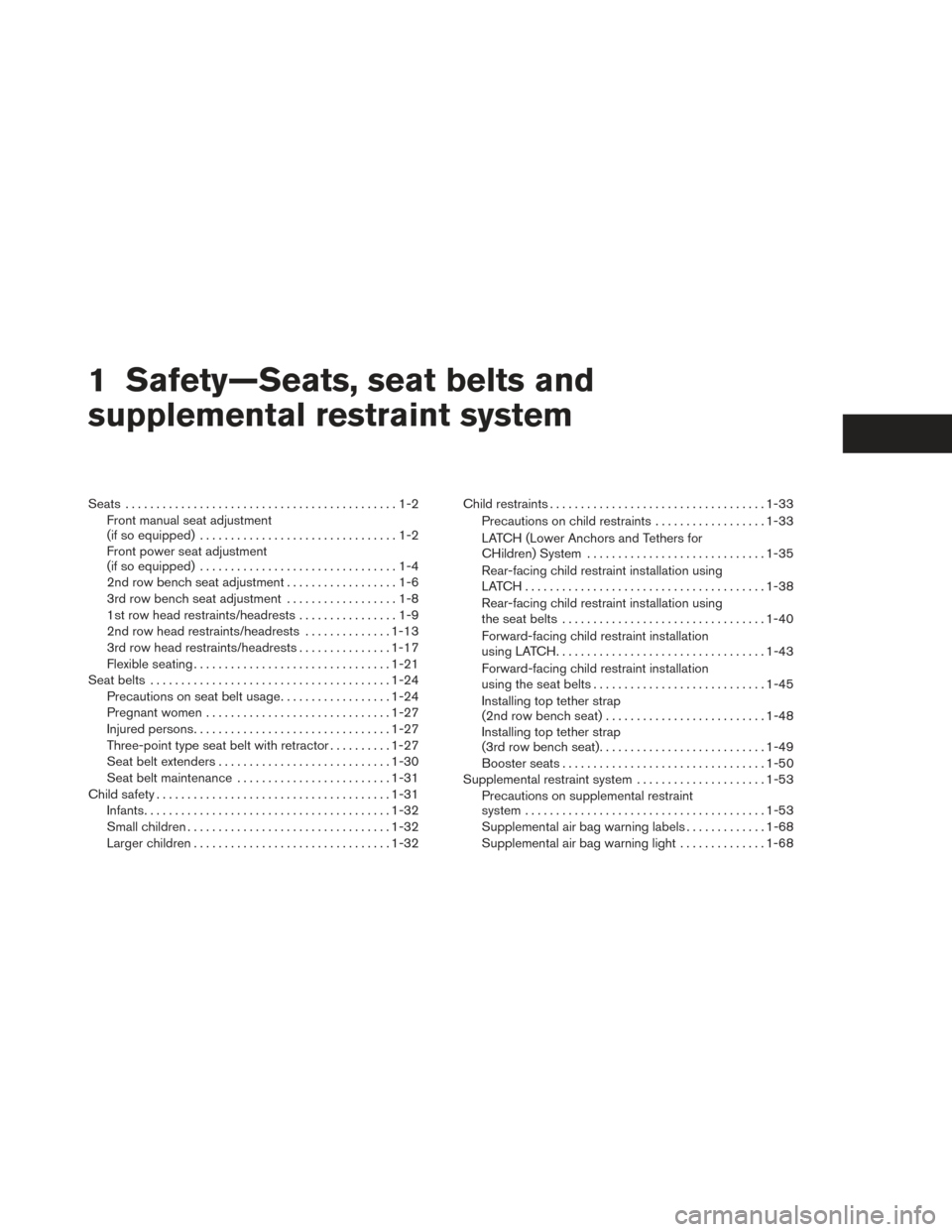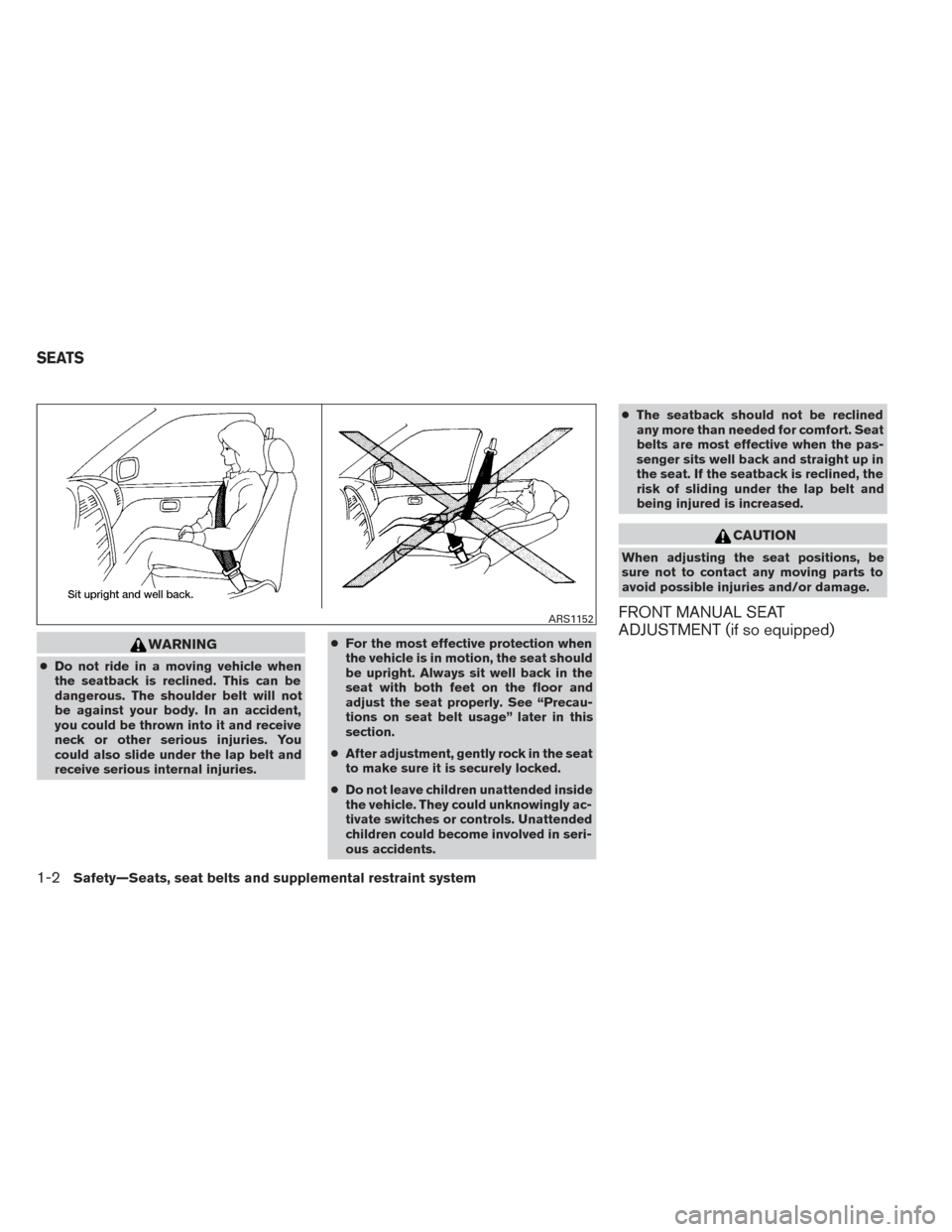Page 85 of 571
Table of
ContentsIllustrated table of contents
Safety—Seats, seat belts and supplemental restraint system
Instruments and controls
Pre-driving checks and adjustments
Monitor, climate, audio, phone and voice recognition systems
Starting and driving
In case of emergency
Appearance and care
Maintenance and do-it-yourself
Technical and consumer information
Index
0
1
2
3
4
5
6
7
8
9
10
Page 87 of 571
0 Illustrated table of contents
Air bags, seat belts and child restraints..............0-2
Exterior front ......................................0-3
Exterior rear .......................................0-4
Passenger compartment ...........................0-5 Instrument panel
...................................0-6
Engine compartment check locations ................0-8
Warning/indicator lights ............................0-9
Page 88 of 571
1. Supplemental front-impact air bags(P.1-53)
2. Occupant classification sensor
(weight sensor)
3. Seat belts (P. 1-24)
4. Head restraints/headrests (P.1-9)
5. Roof-mounted curtain side-impact
supplemental air bag (P. 1-53)
6. 3rd row bench seat top tether strap
anchor (located on bottom of seatback)
(P. 1-49 )
7. Folding 3rd row bench (P. 1-8)
8. 2nd row seat top tether strap anchor
(located on bottom of seatback)
(P. 1-48)
9. LATCH (Lower Anchors and Tethers for
CHildren) (P. 1-35)
10. Folding 2nd row bench (P. 1-6)
11. Front seat-mounted side-impact
supplemental air bag (P. 1-53)
12. Seat belt with pretensioner (P. 1-67)
13. Seats (1st row) (P. 1-2)
See the page number indicated in paren-
theses for operating details.
LII2081
AIR BAGS, SEAT BELTS AND CHILD
RESTRAINTS
0-2Illustrated table of contents
Page 94 of 571
VQ35DE engine
1. Power steering fluid reservoir (P. 8-12)
2. Engine coolant reservoir (P. 8-16)
3. Drive belt location (P.8-16)
4. Fuse box (P. 8-21)
5. Engine oil filler cap (P. 8-10)
6. Brake fluid reservoir (P. 8-12)
7. Air cleaner (P. 8-18)
8. Fuse box (P. 8-21)
9. Fuse box/Fusible links (P. 8-21)
10. Fuse box (P. 8-21)
11. Battery (P. 8-14)
12. Engine oil dipstick (P. 8-9)
13. Radiator cap (P. 8-7)
14. Windshield-washer fluid reservoir(P. 8-13)
See the page number indicated in paren-
theses for operating details.
LDI2266
ENGINE COMPARTMENT CHECK
LOCATIONS
0-8Illustrated table of contents
Page 95 of 571
Warninglight Name Page
Anti-lock Braking
System (ABS) warn-
ing light 2-10
or
Brake warning light 2-11
Charge warning
light
2-11
Low tire pressure
warning light2-11
Master warning light 2-13
Power steering
warning light2-13
Seat belt warning
light and chime2-13
Warning
light Name Page
Supplemental air
bag warning light 2-14
Indicator
light Name Page
Fog light indicator
light (if so equipped) 2-14
Front passenger air
bag status light2-14
High beam indicator
light (blue)2-14
Malfunction Indica-
tor Light (MIL)2-14
Overdrive off indica-
tor light2-15
Security indicator
light2-15
Indicator
light Name Page
Slip indicator light 2-15
Tow mode ON indi-
cator light (if so
equipped) 2-16
Turn signal/hazard
indicator lights
2-16
Vehicle Dynamic
Control (VDC) off
indicator light2-16
WARNING/INDICATOR LIGHTS
Illustrated table of contents0-9
Page 97 of 571

1 Safety—Seats, seat belts and
supplemental restraint system
Seats ............................................1-2
Front manual seat adjustment
(if so equipped) ................................1-2
Front power seat adjustment
(if so equipped) ................................1-4
2nd row bench seat adjustment ..................1-6
3rd row bench seat adjustment ..................1-8
1st row head restraints/headrests ................1-9
2nd row head restraints/headrests ..............1-13
3rd row head restraints/headrests ...............1-17
Flexible seating ................................ 1-21
Seat belts ....................................... 1-24
Precautions on seat belt usage ..................1-24
Pregnant women .............................. 1-27
Injured persons ................................ 1-27
Three-point type seat belt with retractor ..........1-27
Seat belt extenders ............................ 1-30
Seat belt maintenance ......................... 1-31
Child safety ...................................... 1-31
Infants ........................................ 1-32
Small children ................................. 1-32
Larger children ................................ 1-32Child restraints
................................... 1-33
Precautions on child restraints ..................1-33
LATCH (Lower Anchors and Tethers for
CHildren) System ............................. 1-35
Rear-facing child restraint installation using
LATCH....................................... 1-38
Rear-facing child restraint installation using
the seat belts . . ............................... 1-40
Forward-facing child restraint installation
using LATCH. . . ............................... 1-43
Forward-facing child restraint installation
using the seat belts ............................ 1-45
Installing top tether strap
(2nd row bench seat) .......................... 1-48
Installing top tether strap
(3rd row bench seat) ........................... 1-49
Booster seats ................................. 1-50
Supplemental restraint system .....................1-53
Precautions on supplemental restraint
system ....................................... 1-53
Supplemental air bag warning labels .............1-68
Supplemental
air bag warning light ..............1-68
Page 98 of 571

WARNING
●Do not ride in a moving vehicle when
the seatback is reclined. This can be
dangerous. The shoulder belt will not
be against your body. In an accident,
you could be thrown into it and receive
neck or other serious injuries. You
could also slide under the lap belt and
receive serious internal injuries. ●
For the most effective protection when
the vehicle is in motion, the seat should
be upright. Always sit well back in the
seat with both feet on the floor and
adjust the seat properly. See “Precau-
tions on seat belt usage” later in this
section.
● After adjustment, gently rock in the seat
to make sure it is securely locked.
● Do not leave children unattended inside
the vehicle. They could unknowingly ac-
tivate switches or controls. Unattended
children could become involved in seri-
ous accidents. ●
The seatback should not be reclined
any more than needed for comfort. Seat
belts are most effective when the pas-
senger sits well back and straight up in
the seat. If the seatback is reclined, the
risk of sliding under the lap belt and
being injured is increased.
CAUTION
When adjusting the seat positions, be
sure not to contact any moving parts to
avoid possible injuries and/or damage.
FRONT MANUAL SEAT
ADJUSTMENT (if so equipped)ARS1152
SEATS
1-2Safety—Seats, seat belts and supplemental restraint system
Page 99 of 571
Forward and backward
Pull the center of the bar up and hold it while you
slide the seat forward or backward to the desired
position. Release the bar to lock the seat in
position.
Reclining
To recline the seatback, pull the lever up and lean
back. To bring the seatback forward, pull the lever
up and lean your body forward. Release the lever
to lock the seatback in position.
The reclining feature allows adjustment of the
seatback for occupants of different sizes for
added comfort and to help obtain proper seat
belt fit. See “Precautions on seat belt usage” later
in this section. Also, the seatback can be reclined
to allow occupants to rest when the vehicle is
stopped and the shift lever is in the P (Park)
position.
Seat lifter (if so equipped for driver’s
seat)
Pull up or push down the adjusting lever to adjust
the seat height until the desired position is
achieved.
LRS2160LRS2161LRS2202
Safety—Seats, seat belts and supplemental restraint system1-3